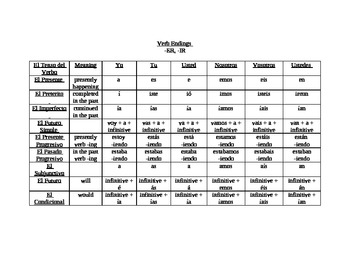
Use this visual to help your students remember them easily and quickly This set includes: a visual of the Special 12/Dirty Dozen Preterite Irregular stems and their endings. Attach the ending that matches the tense, pronoun, and verb type. Take off the ending, either ar, -er, or -ir. Do you want to say that he speaks, we speak etc.


To conjugate an -ar verb, remove the infinitive ending (-ar) and add the ending that matches the subject.You can find these endings in the table below. To learn the basic steps to verb conjugation, we will be looking at the present tense. For friends, cousins, or romantic dating relationships you would use "Te quiero. Students always struggle with learning their preterite irregulars. Below youll find instructions for forming regular verbs in the present tense, including the endings you need to know for -ar, -er, and -ir verbs. "Te amo" (teh- ah-moh) simply means "I love you." Te is the word that means YOU, and amo the conjugated form of amar for the yo pronoun (first person, singular.) This is for a deep love, committed relationship - with immediate family or your spouse. All Spanish verbs end in -ar, -er, or -ir (Never ever do they end in -or.) That's the noun form of the word, "the love." People of many languages use "mi amor," my love, as an affectionate nickname, or pet name. In the exercises, you can practise the conjugation of different Spanish tenses. You can practice conjugation on or off-line, but be sure to check out ’s conjugation drills, conjugation charts, and interactive lessons Ah, the conjugation of verbs. The table below provides an overview of the Spanish indicative tenses including examples of the conjugation of -ar, -er and -ir verbs as well as some general usage rules for each tense. So, the regular conjugation is above, and using the "opposite ending" for amemos means "Let's do this, but it may or may not happen." It's i nteresting to think of, really.įinally, we have the more common word, el amor. Conjugation is, essentially, changing a verb to reflect who or what performed the action described by the verb, as well as when it took/takes/will take place. (I love, you love, he loves, we love, you (plural) love, they love.) The present tense conjugation of this verb, "amar ~ to love" as in, it's HAPPENING, no question, is: This is called the "subjunctive tense" in Spanish grammar. Just because we WANT to do it, doesn't mean it's going to be done. Like with any "let's do this" type of feeling. Here's a little verb grammar: When we use the "opposite ending" for verbs when it's a verb contrary to fact. "Dear children, let us not love with words or speech but with actions and in truth."īeing the teacher I am, I focused in on amar. Example: canto, I sing."Hijos, no amemos de palabra ni de lengua, sino de hecho y en verdad. Preterite Irregulars Special Twelve Dirty Dozen Visual Handout - el preterito. In many cases the verb form gives enough information that it isn't necessary to indicate with a subject noun or pronoun who is performing the action. Examples: yo hablo, I talk tú hablas, you (singular) talk él habla, he talks ella habla, she talks nosotros hablamos, we talk ellos hablan, they talk. For regular verbs, the -ar, -er or -ir at the end is replaced with the appropriate ending.

No suffix is added to indicate any subject other than the third person (someone other than the person speaking, also known as the first person, or the person being spoken to, the second person). In English, an "-s" is added at the end of most verbs to indicate that it is being used in the third-person, present-tense singular form. I talk, you talk, he talks, she talks, we talk, they talk.


 0 kommentar(er)
0 kommentar(er)
